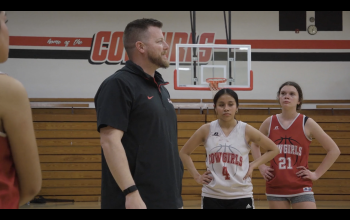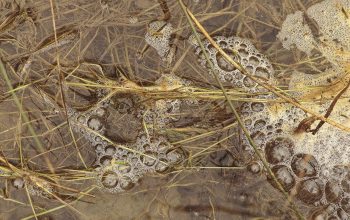At just the age of nine, Addi Hollman has become quite the conservationist. Amazingly, since the age of three, Addi has been trying to “save the monarchs,” she says. She and her grandparents, Tami and Dale Hollman, all of Rowan, are working towards monarch butterfly conservation and are enjoying every minute of it.
The Hollmans explain that this is a worthwhile project since monarch butterfly populations have declined dramatically in the past few decades. For Addi, her work with the pretty orange and black insects started as a toddler when her grandfather explained the life cycle of the butterflies to her. Dale and Tami noted that they have always been “nature freaks,” enjoy the outdoors and are avid birders, so the interest in butterflies comes naturally to the whole family.
For their conservation efforts, Addi described the process. First, they collect the eggs that the adult monarchs lay, which are just tiny specks that they find on milkweed. The eggs take a couple days to hatch into itty bitty caterpillars. The caterpillars eat lots of milkweed and grow rapidly, then hang upside down to form a chrysalis, the cocoon-like structure that looks like an elongated green acorn with some shiny gold color on it. The chrysalises are built in special tents that allows the Hollmans to hatch several monarchs at once. Addi said that they previously used jars which took up a lot of space.
After about two weeks in the chrysalis stage, the adult butterfly emerges and is ready to fly in short order after unfolding their wings. When the butterflies are ready to take flight, Addi takes them outside in the tents and sends them on their way.
Dale notes that they have improved their hatching process over the last few years. “In previous years, we released fewer grown monarchs, only 34 per summer at the most.” This year, they are now getting close to the 200 mark! Dale added that they can work at the project from late May all the way to October, when the monarchs head south.
When Addi is asked why the monarchs need extra help, she informed that only about 10% of the butterflies survive naturally in the wild due to parasites. With their efforts, the Hollmans have much better numbers. Monarchs importantly act as pollinators for all kinds of flowers and plants, including cucumbers, Addi’s favorite. She stated that her favorite part of the project is feeding the caterpillars milkweed.
Addi and her grandparents are serious about their monarch conservation efforts. They are members of Monarch Watch, a nonprofit education, conservation, and research program that focuses on the monarch butterfly. They have also established various Monarch Waystations in Rowan to help with the efforts. Monarch Waystations are places that provide resources necessary for monarchs to produce successive generations and sustain their migration. You can see some of these waystations in downtown Rowan by the playground and post office.
Addi has also recently spoke to the Rowan City Council about planting more milkweed to provide monarch habitat. She added that that is the single best thing people can do for monarchs – not destroy milkweed.
Dale emphasized that this project has been valuable not only for monarch conservation, but in how they’ve seen Addi grow through it. “Getting to watch her explain this to people and see the impact she has is just amazing,” he said.
For her part, Addi said she just loves to help the butterflies. She has promised her grandfather that no matter where she goes later in life, she’ll still be working to save the monarchs. With that determination, she will no doubt achieve great things.



